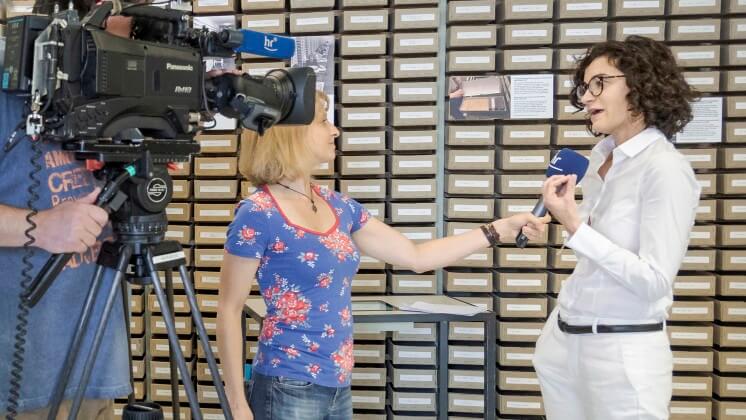A living archive that is growing all the time: The Arolsen Archives Online

Why is it so important to digitize the world’s largest collection of documents on Nazi persecution and publish them on the internet? What can archives do about fake news? Floriane Azoulay, the Director of the Arolsen Archives, answers these questions and more. Together with her team, she has developed new goals and a comprehensive digital strategy for the institution in recent years.
Ms. Azoulay, what do the Arolsen Archives aim to achieve by publishing their collections online?
We are making our documents accessible – to people of all ages all over the world. And we provide additional contextual information as a tool to help people understand the documents and put them into their historical and political context. We are pursuing two main goals: Firstly, we are keeping the memories of Nazi persecution alive and remembering the victims. We want to create a “digital memorial” to the many millions who suffered and died. Secondly, our documents are evidence. They stand for the truth about the Holocaust and about the atrocities committed by the Nazis. By putting the documents online, we are putting this evidence and this truth where it belongs, right at the heart of our society today – as a bulwark against Holocaust deniers, fake news, and the distortion of historical facts.
How do you manage the technological realization?
We are very grateful to our partner Yad Vashem for taking care of the technical side for us. They support us in achieving the overall aim of augmenting Holocaust documentation and making it available worldwide. The online archive utilizes Yad Vashem’s state-of-the-art technology for fast data management, as well as the unique database for retrieval of names and places developed by the scholars at Yad Vashem Archives. This provides greater accessibility and usability of Holocaust documentation.
Twenty-six million of the 30 million historical documents from the Arolsen Archives are now available on the internet. Which documents aren’t online yet?
Some of the documents have to be digitized first. And there are a small number of documents that aren’t online because publishing them could constitute an invasion of personal privacy. This applies to medical files, for example. In addition, we don’t have permission to publish copies of documents from other archives in many cases. Taken together, these various categories make up the four million documents from our historical collections that are not online. We also have many millions of documents that were created during the course of the institution’s work. We will be turning our attention to these in the coming years – including our Central Name Index, for example, which is a very special collection: This index was created by employees as an aid to help them in their work. It contains millions of names of victims of Nazi persecution. This makes it immensely valuable for society today. Like our historical collections, it belongs to UNESCO’s Memory of the World. We are currently exploring ways to provide access to this index.
You are even putting collections online that cannot yet be searched for keywords. Why?
Over the past few years, our attitude to putting documents online has changed dramatically. In the past, we wanted to “open a window” onto the archive in order to draw attention to our holdings and to the services we provide. Today, we take a different view: The online archive is our archive. It comes right into people’s living rooms, and they can access everything it holds without leaving the house. That’s why we are making so many documents available as quickly as we possibly can, instead of waiting until a collection has been indexed to perfection and can be searched for every single piece of information it contains. We will simply add descriptions and contextual information later on. This is a reflection of the way we see our users today, too. In the past, we didn’t give them much responsibility. But the users of our online archive know what they are doing. We want to let them decide when and how to use our documents.
How are you going to make the documents more searchable?
We continue to rely on manual indexing, and we have staff who are well qualified for the task. However, because we are dealing with so many documents, we also have to use external service providers, and then we just perform quality checks ourselves. We are also testing automatic indexing software. And we have just launched a large-scale crowdsourcing project called “Every name counts”: We are using an online platform so that anyone who wants to can help us to enter the names of victims of Nazi persecution in the online archive.
When will the digitization process be completed?
We aim to put all the documents online and finish indexing all the names by 2025. But the process of digitizing our collections will never really be “finished”. We are a living archive, that will continue to grow online indefinitely, partly through links to information from outside the Arolsen Archives, and in future, this will make it possible to reconstruct people’s life journeys. Users will be able to contribute documents and information of their own.

